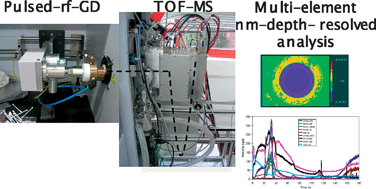Direct solid analysis of bulk and thin coated glasses by pulsed radiofrequency (rf) glow discharge time-of-flight mass spectrometry (GD-TOFMS) is investigated. Modulated low pressure plasma created by pulsed-rf-GD has been coupled to a fast TOFMS in order to obtain complete mass spectra information from the different GD pulse domains (pre-peak, plateau and afterglow). In particular, it was observed that the analytes show the highest atomic ion signals in the afterglow region some hundred microseconds after the maximum of the Ar ion signal. However, it should be highlighted that the analyte ions exhibited their peak maxima at different delay times, depending on the element, after the end of the GD pulse. Such ion signal delays have been measured for different selected isotopes, covering a mass spectrum from light to heavy isotopes at different conditions of pressure and applied power. The results showed that ion signal delays are influenced by both the isotope mass and the pressure of the GD. Furthermore, GD operating conditions (pressure and applied power) were optimised in terms of sensitivity, using a bulk glass certified reference material (NIST 1411). The best analytical performance was observed at low pressure (150–200 Pa) and high applied power (135 W). Moreover, different pulse GD duty cycles (relationship between pulse duration and pulse period) were investigated. An optimum value of 50–65% duty-cycle was selected considering the signal stability and the signal intensity.
The previously optimized pulsed-rf-GD-TOFMS system was then evaluated for qualitative in-depth profile analysis of thin coatings deposited onto thick glass substrates. High depth resolution (nm range), comparable to that obtained using rf-GD-OES was achieved. However, the observed depth resolution using the ToF-SIMS system is still superior. In this sense, analytical figures of merit observed in our pulsed-rf-GD-TOFMS demonstrate its great analytical potential for high depth resolution analysis of coated glasses.


 Please wait while we load your content...
Please wait while we load your content...